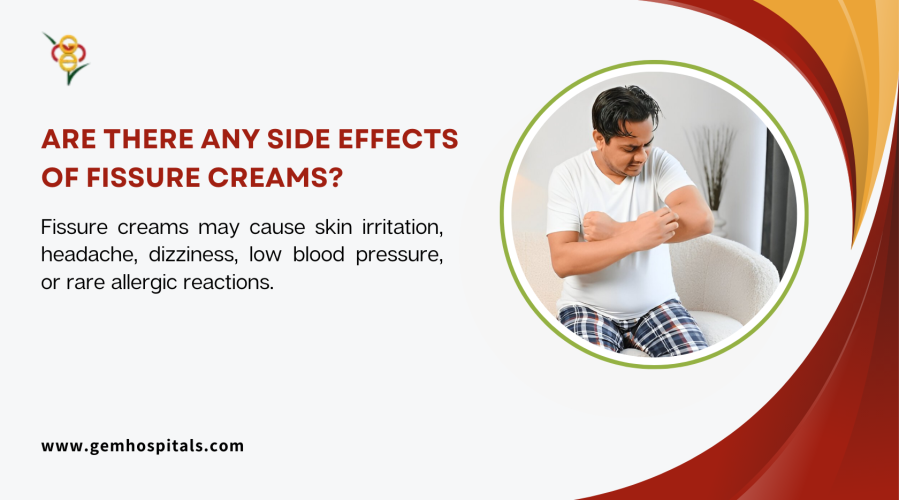Advanced surgical care for upper GI disorders including esophagus, stomach, and duodenal conditions. Learn about diagnosis, minimally invasive treatments, and expert surgical solutions.
Are There Any Side Effects of Fissure Creams?

Anal fissures, small tears in the lining of the anus, can be quite painful and difficult to manage. Fissure creams are among the most commonly prescribed treatments, designed to provide relief and promote healing. However, while they are generally safe, it’s crucial for users to understand the potential side effects of these creams. Knowing what to expect can help individuals use them more safely and recognize when to consult a doctor. This guide will cover how fissure creams work, common and rare side effects, precautions for safe use, and indicators that it might be time to seek professional advice.
How Fissure Creams Work
Fissure creams work primarily by relaxing the muscles surrounding the anal fissure, reducing pain, and encouraging blood flow to the affected area. The most commonly used active ingredients in these creams include nitroglycerin, calcium channel blockers, and lidocaine. Each has a distinct effect:
- Nitroglycerin: Nitroglycerin-based creams help widen blood vessels, easing blood flow and reducing muscle spasms in the anal area. This action relieves pressure on the fissure, leading to reduced pain and improved healing. However, nitroglycerin is known to have some side effects, which we’ll discuss further.
- Calcium Channel Blockers: These medications are typically used to manage high blood pressure, but in the case of fissures, they help relax the muscles around the anus. By reducing tension and spasms, they provide relief and assist in the healing process.
- Lidocaine: Lidocaine is a topical anesthetic that numbs the area, providing quick but temporary relief from pain. It doesn’t directly heal the fissure but makes symptoms more manageable.
These creams, if applied as prescribed, can go a long way to easing pain and discomfort for many people. However, they change the body’s normal response, and this makes them have side effects that may be mild or severe.
Common Side Effects of Fissure Creams
Fissure creams work well but most users develop mild side effects. These are usually temporary and subside as the body adjusts to the medication, but it’s still good to know what to expect:
- Local Irritation: The most often reported side effect is a sensation of burning or itching at the site of application. This occurs when the active ingredients of the products have sunk into the skin and might cause slight irritation. In most cases, the feeling disappears after a few minutes.
- Redness and Swelling: Redness and swelling of the skin surrounding the area in which the cream has been applied may occur. This reaction normally subsides with time as the body adapts to the treatment. But if the redness and swelling are prolonged and become worse, then it is an indication of irritation or an allergy.
- Headaches: Nitroglycerin-based creams often cause headaches. Nitroglycerin leads to vasodilation and this is the reason why some people develop headaches when they use it. They are normally not severe, but these headaches can be quite annoying. In case of severe or unbearable headaches, the users should consult other options with their doctor.
- Dizziness: Some of the side effects include dizziness, especially if one applies the cream then stand up from a sitting position. Because of this, it is recommended to sit or lie down for some time after applying the cream to prevent fainting.
The majority of patients experience these side effects as mild, but any reactions should be closely observed and a doctor should be consulted when the side effects increase or persist with further use of the drug.
Rare but Serious Side Effects
Despite this, there are some more severe side effects that may be linked to the fissure creams. Users should be aware of these to ensure they can take prompt action if needed:
- Severe Skin Reactions: As a very rare side effect, some people may develop severe skin reactions at the site of the application, or develop blisters or itching. Such signs may be a sign of an allergic reaction or intolerance to one of the components of the cream. If you experience any of these symptoms, it is recommended that you stop use and seek medical advice.
- Allergic Reactions: While rare, there may be allergic reactions that may arise. Symptoms of anaphylaxis include severe skin redness, breathing problems, and rashes. If you have any of these symptoms, call an emergency medical service because these symptoms may indicate a severe condition.
- Low Blood Pressure: Some fissure creams have chemicals that dilate blood vessels and therefore anybody sensitive to this will develop low blood pressure. This condition is more likely in patients already on blood pressure medication or those who have low blood pressure. Signs of low blood pressure include dizziness, lightheadedness, or even passing out, weakness or fatigue. If you have such symptoms, it is necessary to stop using the cream and seek medical advice.
Awareness of such symptoms can make the users act early in order to avoid further development of complications.
Precautions and Tips for Safe Use
To use fissure creams safely and minimize the risk of side effects, consider these practical tips:
- Follow the Prescribed Dosage: It is always important to use the cream as prescribed by the doctor. Side effects of this cream are likely to occur if one uses the product or applies it on the skin more often than the recommendations.
- Test for Allergies: If it’s the first time you are using the cream or any of the ingredients, you should test the cream on a less sensitive part of the body, such as the inside of the elbow. Do not apply it to the affected area without waiting for a reaction for at least 24 hours.
- Practice Good Hygiene: Make sure the skin area to be applied the cream is clean and dry before applying it. Practicing good hygiene can help to prevent the likelihood of an infection or an irritation.
- Avoid Long-Term Use: Fissure creams are meant for short term application. Their use for long durations is counterproductive and increases the probability of developing side effects. If the symptoms do not disappear, seek medical advice regarding other therapies.
In this way, users can avoid the side effects and make sure they are using the cream properly and securely.
When to Consult a Doctor
There are certain situations where consulting a doctor is essential to ensure safety and well-being:
- Persistent or Worsening Symptoms: If you do not notice any changes within a few days or weeks of applying the cream, you may need to look for a better solution for your skin issue. It is advisable to consult your doctor to check other possible solutions.
- Serious Side Effects: If you have any severe reactions, for example, persistent irritation, very strong headaches, or any signs of an allergic reaction, consult your doctor immediately. If the problem is addressed at an early stage then the complications are easily avoided.
- Chronic or Recurring Fissures: Fissures that are persistent may need a more aggressive treatment, such as surgery, to avoid further pain. If cracks appear repeatedly, one should seek a doctor’s advice on other forms of treatment apart from the use of cream.
Conclusion
People experiencing the pain from an anal fissure can use fissure creams and this is safe and can be effective. This information can help users to make informed decisions about the clinical treatment while minimizing the side effects on their health. If you want to get more detailed information and individual approach, go to the GEM Hospital page and Book your appointment.
Our specialists at GEM Hospital are here to help you to achieve the best safe treatments according to your condition.
Blogs & Article
Learn about esophagogastric surgery, the conditions it treats, and the latest surgical options available for disorders of the esophagus and stomach, including minimally invasive procedures.
Learn about surgical treatment options for esophagus and stomach disorders, including advanced procedures, benefits, and when surgery is recommended for better digestive health.


